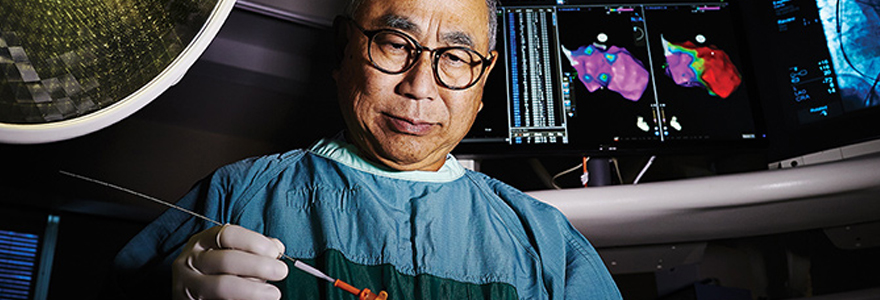The heart of the matter

Dr. Anthony Tang leads CANet, a new $26.3-million, Canada-wide network focused on improving arrhythmia care
“We need to have patients as part of planning the research to reflect what’s important to them.” —Dr. Anthony Tang
By Pat Morden, BA’77
When he was growing up in Hong Kong, Dr. Anthony Tang didn’t want to be a doctor. “I had the impression that doctors made a lot of money but didn’t necessarily have a lot of fun.”
Fortunately, Dr. Tang changed his mind. He is now a world-renowned cardiologist and researcher at Schulich Medicine & Dentistry, and Chief Executive Officer of the new Canadian Arrhythmia Network.
Dr. Tang moved to Canada after high school. As a science student at the University of Toronto, he found many of his friends focused on winning a place in the medicine program. As he puts it, he “decided to give it a try and just happened to get in.”
When he graduated, he practised family medicine for two years, and then turned to cardiology. It appealed to him because he finds the specialty is intellectually challenging and requires a high level of technical skill.
During training at Duke University Dr. Tang’s interest in arrhythmia research began to crystallize. Intrigued by its scientific and mathematical underpinnings, he also saw it as a fit with his training in medicine. “I am a physician first,” he said. “I believe research has to be grounded in the care we provide to patients.” Even today, Dr. Tang continues to practise as a cardiologist. He enjoys the diversity of his work, encompassing research, teaching and care.
When his training was complete, Dr. Tang became Director of Electrophysiology and Director of Cardiology Research at the Ottawa Heart Institute, and then moved to Victoria to work with the Vancouver Island Health Authority.
His research career mirrored the remarkable achievements in cardiology during the past quarter century. He was involved in research to develop better ways to stop arrhythmias through the use of external defibrillation, and then helped develop the first implantable defibrillator devices. He also contributed to the development of cardiac resynchronization therapy, now a widely accepted treatment option for heart failure patients. His work, together with many others, advanced the practice of catheter ablation, and one of his projects at the moment is exploring ablation to treat atrial fibrillation in heart failure.
He moved to Schulich Medicine & Dentistry in 2013. He was drawn by the School’s strong program in arrhythmia research, led for many years by Dr. George Klein.
Dr. Tang was also attracted by the strong culture of teamwork and collaboration at the School. It’s the same spirit that makes the Canadian research community successful, he believes. “Canadians in my field work very closely together,” he said. “We don’t have a lot of large centres like Mayo or Cleveland Clinic, but collectively we are stronger than any one of them.”
The spirit of collaboration was formalized in the Canadian Arrhythmia Network (CANet) as part of the federal government’s Networks of Centres of Excellence program. The $26.3-million funding was announced in December 2014.
CANet’s goals during the next ten years are ambitious: to reduce sudden cardiac deaths by 10 per cent; to reduce the disease burden of atrial fibrillation by 20 per cent; to reduce health-care utilization as a result of syncope by 30 per cent; to commercialize five or more new technologies; and to train 30 to 40 skilled arrhythmia researchers. Dr. Tang was a natural choice for CEO as he has been providing leadership to the arrhythmia community for many years.
“The funding will enable researchers to build on their excellent work and go further,” said Dr. Tang. “We will have the capability to integrate our research beyond just clinical physicians.”
CANet will include engineers, social scientists, partners from industry, policymakers and representatives from other sectors and disciplines. It’s important to Dr. Tang that it will also include patients. “We need to have patients as part of planning the research to reflect what’s important to them.”
Among the projects currently being considered is the development of cell phone-based technology to help diagnose and advise patients on a personalized basis. The goal is to ensure that those who need tertiary care get it quickly, while those who don’t need the high level of care aren’t stuck on long waiting lists. Other projects will develop better diagnosis and treatment approaches, with a view to both effectiveness and efficiency.
Dr. Tang says it’s time that researchers took a more pragmatic approach. “We need to develop new solutions that make sense for patients, make sense for the health provider, and make sense for health economics,” he said. “The only way we can achieve that is to all work together.”








